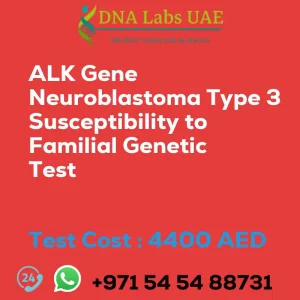COL2A1 Gene Otospondylomegaepiphyseal dysplasia Genetic Test
Are you concerned about otospondylomegaepiphyseal dysplasia (OSMED) and looking for genetic testing options? DNA Labs UAE offers the COL2A1 Gene Otospondylomegaepiphyseal dysplasia Genetic Test to help diagnose this rare genetic disorder.
Test Details
The COL2A1 gene is responsible for producing a protein called type II collagen, which is a major component of cartilage and other connective tissues in the body. Mutations in the COL2A1 gene can lead to OSMED, a rare genetic disorder characterized by skeletal abnormalities, hearing loss, and vision problems.
Individuals with OSMED may experience short stature, abnormal development of the bones in the spine and ears, and varying degrees of hearing loss. They may also have eye abnormalities such as nearsightedness, cataracts, or retinal detachment.
To diagnose OSMED, DNA Labs UAE utilizes NGS (next-generation sequencing) technology for genetic testing. NGS genetic testing allows for the simultaneous analysis of multiple genes, including the COL2A1 gene. This comprehensive approach helps confirm a diagnosis of OSMED and provides information about the specific mutation in the gene causing the disorder.
Test Components and Price
- Test Name: COL2A1 Gene Otospondylomegaepiphyseal dysplasia Genetic Test
- Components: NGS Technology
- Price: 4400.0 AED
- Sample Condition: Blood or Extracted DNA or One drop Blood on FTA Card
- Report Delivery: 3 to 4 Weeks
- Test Type: Dysmorphology
- Doctor: Pediatrics
- Test Department: Genetics
Pre Test Information
Prior to undergoing the COL2A1 Gene Otospondylomegaepiphyseal dysplasia NGS Genetic DNA Test, it is important to provide the clinical history of the patient. Additionally, a genetic counseling session will be conducted to draw a pedigree chart of family members affected by COL2A1 Gene Otospondylomegaepiphyseal dysplasia.
Why Choose NGS Genetic Testing?
NGS genetic testing is a powerful tool in diagnosing genetic disorders. By analyzing multiple genes simultaneously, healthcare providers can make accurate diagnoses, provide information about the prognosis of a genetic disorder, and guide treatment decisions. With the COL2A1 Gene Otospondylomegaepiphyseal dysplasia Genetic Test, DNA Labs UAE aims to provide comprehensive and reliable results to aid in the management of OSMED.
| Test Name | COL2A1 Gene Otospondylomegaepiphyseal dysplasia Genetic Test |
|---|---|
| Components | |
| Price | 4400.0 AED |
| Sample Condition | Blood or Extracted DNA or One drop Blood on FTA Card |
| Report Delivery | 3 to 4 Weeks |
| Method | NGS Technology |
| Test type | Dysmorphology |
| Doctor | Pediatrics |
| Test Department: | Genetics |
| Pre Test Information | Clinical History of Patient who is going for COL2A1 Gene Otospondylomegaepiphyseal dysplasia NGS Genetic DNA Test. A Genetic Counselling session to draw a pedigree chart of family members affected with COL2A1 Gene Otospondylomegaepiphyseal dysplasia NGS Genetic DNA Test gene COL2A1 |
| Test Details |
The COL2A1 gene is responsible for producing a protein called type II collagen, which is a major component of cartilage and other connective tissues in the body. Mutations in the COL2A1 gene can lead to a rare genetic disorder called otospondylomegaepiphyseal dysplasia (OSMED). OSMED is characterized by skeletal abnormalities, hearing loss, and vision problems. Individuals with OSMED typically have short stature, abnormal development of the bones in the spine and ears, and hearing loss that can range from mild to severe. They may also have abnormalities in the eyes, such as nearsightedness, cataracts, or retinal detachment. NGS (next-generation sequencing) genetic testing is a type of genetic test that can analyze multiple genes simultaneously. In the case of OSMED, NGS genetic testing can be used to identify mutations in the COL2A1 gene. This can help confirm a diagnosis of OSMED and provide information about the specific mutation in the gene that is causing the disorder. NGS genetic testing is a powerful tool in diagnosing genetic disorders, as it allows for the simultaneous analysis of multiple genes. It can help healthcare providers make accurate diagnoses, provide information about the prognosis of a genetic disorder, and guide treatment decisions. |








